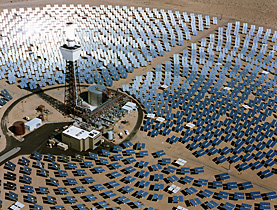
Saharan solar project moves closer to reality

A dozen major firms have signed an agreement to build a $555 billion (SFr602 billion) solar thermal project in the Sahara desert to pump clean power back into Europe.
The project, dubbed Desertec, has the backing of international heavyweights including Siemens, Deutsche Bank and ABB, the builders of Zurich’s power grid.
At a meeting in Munich on Tuesday, German utility companies, United States solar energy entrepreneurs and Swiss transmission experts ABB signed a memorandum of understanding with a dozen groups to analyse and develop the technical, economical and political framework for the project.
The idea is one of the most ambitious renewable-energy projects to be launched, with plans calling for hundreds of thermal plants scattered across the North African desert and massive underwater high-voltage cables to bring the power back to Europe.
The project could take 40 years to finish and might one day supply Europe with 15 per cent of its energy demands. North Africa and the Middle East would also benefit.
“The full potential of renewable energy in Europe and North Africa is huge,” said Joachim Schneider, head of ABB’s power products division. “Climate protection needs innovative technologies.”
Concrete steps
The idea to use deserts as long-distance solar farms for other regions, though seemingly obvious, has been something of a fantasy due to problems with efficient transmission lines, generating capacity of solar cells and political issues for a project that involves dozens of countries.
While ABB studies show that the world’s deserts collect more energy in six hours than the entire human population can consume in one year, solar-cell technology for the moment is still too expensive to harness it on such a massive scale, Wolfram Eberhardt, ABB spokesman told swissinfo.ch.
“You have to remember this is a long-term project,” he said. “Wind power has gone through a lot of development in the past ten years but solar isn’t as economical as it should be. This is still a concrete step forward.”
However Eberhardt says while solar technology improves, ABB already has the capability to transfer the power back to Europe with massive cables strung over great distances without losing more than ten per cent of the total power. It has already accomplished similar tasks in China, Norway and the Netherlands.
“It’s not just technology partners who are involved,” Eberhardt said. “It’s also financing and insurance companies. This is exactly the kind of mix you need to bring a vision into a long-term reality.”
Meeting energy demands
The Switzerland-based arm of environmental group Greenpeace, which has been following the Desertec plan for years now, largely supports the project.
“We have so many desert regions and when we can use a portion of those for solar energy then we can replace fossil-fuel energy and make a real contribution to climate change,” Urs Wittwer, a Greenpeace energy campaigner told swissinfo.ch. “The sun shines for free.”
Even if the technology does not exist today to be able to do in its entirety what Desertec aims to do, the potential of solar energy is bigger than that of other renewable sources, like wind, which is more economical at the moment, he said. Projects like this could help solar technology catch up.
In the meantime, the 12 companies that gathered in Munich to form the Desertec Industrial Initiative have about three years’ worth of work to do writing business plans and securing financing. The founding members hope to incorporate as a limited liability company under German law by October 31, 2009.
“It has a lot of potential,” Wittwer added. “I don’t think ‘fantasy’ or ‘dream’ are the right words. We’re talking about a vision.
“Big power companies in Switzerland are still investing in foreign coal-fired power plants and arguing for new nuclear power stations. Here we have a chance to invest in and contribute to a big power plant. This is a huge opportunity for them. They just need to use it.”
Tim Neville, swissinfo.ch (with input from Mohamed Chérif)
The founding members of the Desertec Industrial Initiative:
ABB
A BENGOA Solar
Cevital
Deutsche Bank
EON
HSH Nordbank
MAN Solar Millennium
Munich Re
M+W Zander
RWE
SCHOTT Solar
Siemens
The Solar Island venture is another large-scale energy project with Swiss involvement. That project, based in Ras al-Khaimah in the United Arab Emirates, seeks to harness solar energy with large “islands” of solar mirrors that heat water in pipes to make steam and electricity. The islands float out to sea.
The final islands are expected to measure five kilometres in diameter and are being developed by the Swiss Centre for Electronics and Microtechnology in Neuchâtel. The platform of panels sits 20m above the water surface and can rotate to track direct sunlight thanks to motors situated along the circumference.
So far workers have built test platforms about 100m in diameter and have performed pressure tests to make sure the unit is functioning properly.

In compliance with the JTI standards
More: SWI swissinfo.ch certified by the Journalism Trust Initiative





























You can find an overview of ongoing debates with our journalists here . Please join us!
If you want to start a conversation about a topic raised in this article or want to report factual errors, email us at english@swissinfo.ch.